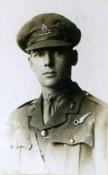
War Memorial
| Captain Lancelot PRICKETT | |
|
71st Heavy Battery, Royal Garrison Artillery and 3 Reserve Squadron, Royal Flying Corps Date of birth: 3rd September 1888 Date of death: 2nd June 1916 Killed on active service aged 27 Buried at Heene (St Botolph) Churchyard Extension, Worthing, Sussex |

|
| Lancelot Prickett was born at 20 Brookdale Avenue, Ilfracombe in Devon on the 3rd of September 1888 the only son of Major William Robert Prickett, Royal Artillery, and Maria Stewart (nee Treffry) Prickett later of Worfield, St Botolph’s Road, West Worthing. He was educated at Hazelwood School until April 1902. On leaving the school, the school magazine wrote the following on him: - "....goes to Marlborough where he has passed a most excellent entrance exam, scoring nearly 80 percent of the possible marks." He went on to Marlborough College where he was in C3 House from May 1902 to December 1905. He went on to be instructed by D.J. Cowles Esq. of Manor House, Felixstowe from January 1906 to May 1907. He applied for the examination for entry to the Royal Military Academy, Woolwich on the 1st of May 1907 and entered in 1908, passing out the following summer. He was commissioned as a 2nd Lieutenant in the Royal Garrison Artillery on the 21st of July 1909 and was promoted to Lieutenant on the 23rd of July 1912. On the 15th of March 1912 he embarked onboard the P&O steamer “Oceana” at Tilbury to travel to Bombay and then on Attock to join the 71st Heavy Battery. At 4am the following morning, while some four nautical miles off Beachy Head, the “Oceana” collided with the German steel barque “Pisaqua”. He related that he only escaped in night attire and lost of all his kit but he was among two hundred and forty three passengers and crew who were rescued, with seventeen dying when No. 1 Lifeboat overturned while being launched while the vessel was still underway. Although the vessel was taken under tow at 8am by the Newhaven Tug "Alert", she developed a severe list and sank at 10am. Following the outbreak of war he returned from India with the 71st Heavy Battery in December 1914 and went to France where he was involved in actions around Ypres and Hill 60. In April 1915 he was seconded to the Royal Flying Corps as an Observer and was posted to No.1 Squadron, 2nd Wing on the 1st of July 1915; he was promoted to Captain on the 21st of July 1915. He was in continuous operations over the German lines until he returned to England for pilot training. He was appointed as a Flying Officer on the 21st of October 1915 and joined 6 Reserve Squadron at Montrose on the 28th of October. He obtained his Aero Certificate (number 2335) at the Military School, Catterick on the 27th of January 1916 flying a Maurice Farman biplane. He was posted to 33 Squadron on the 7th of February 1916 and to 8 Reserve Squadron on the 3rd of March 1916. He was reclassified to Flying Officer from Flying Officer (Observer) on the 5th of May 1916 and was posted to 48 Squadron at Netheravon in Wiltshire for further training. On the 2nd of June 1916 he boarded a Morane-Salunier Type L aircraft with Lieutenant William Archibald Buchanan at Netheravon for a training flight. The aircraft was started in a hangar and taxied out for takeoff. As the aircraft left the ground it banked steeply before side slipping into the ground. Officers and men from the base ran to the wreck site where they managed to drag Buchanan out of the wreckage before the petrol tank exploded. Lancelot Prickett was trapped under the wreckage of the aircraft and could not be rescued. The fire was put out with sand and his body was recovered. Buchanan was taken to Tidworth Hospital where he died of his injuries five days later. A Coroner's Enquiry was held at Netheravon on the 9th of June which heard evidence from Lieutenant P.L. Moore, Royal Army Medical Corps, that Prickett had died from shock and burns. The jury returned a verdict of accidental death. |
|
| Went on to Marlborough College |
Back